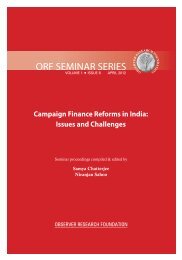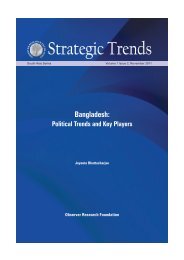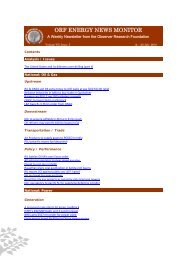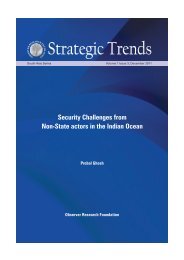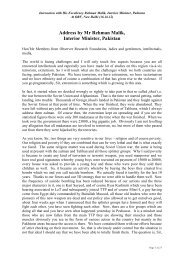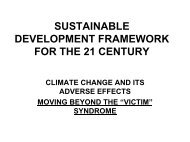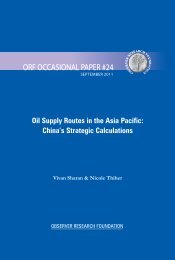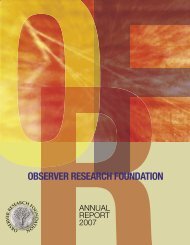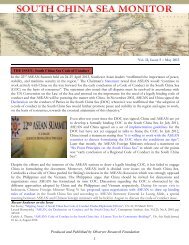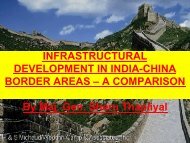Affirmative Action in Private Sector in Malaysia - Observer Research ...
Affirmative Action in Private Sector in Malaysia - Observer Research ...
Affirmative Action in Private Sector in Malaysia - Observer Research ...
You also want an ePaper? Increase the reach of your titles
YUMPU automatically turns print PDFs into web optimized ePapers that Google loves.
government set up the Credit Guarantee Corporation (CGC) which took the job of underwrit<strong>in</strong>g guarantees<br />
for 60 per cent of loans given by commercial banks to small bus<strong>in</strong>essmen (see Lim Mah Hui 1985). In<br />
1977, the CGC had guaranteed 54, 591 loans worth RM480.4 million, with 67 per cent of the total loans,<br />
account<strong>in</strong>g for 42 per cent of the total value, go<strong>in</strong>g to Bumiputera (see Chee, et al, 1979).<br />
15 Despite many of the dis<strong>in</strong>centives, overwhelm<strong>in</strong>g majority of Ch<strong>in</strong>ese bus<strong>in</strong>essmen made profits. For<br />
<strong>in</strong>stance, non-Malays (brute majority of them were Ch<strong>in</strong>ese) sharehold<strong>in</strong>g actually rose from 34.3 percent<br />
<strong>in</strong> 1970 to 40.1 percent <strong>in</strong> 1980 and 46.2 percent (44.9 owned by Ch<strong>in</strong>ese) <strong>in</strong> 1990 (Fourth <strong>Malaysia</strong> Plan).<br />
In every sense, Ch<strong>in</strong>ese made major economic ga<strong>in</strong>s under the NEP regime. Fact is Malay ownership<br />
growth happened largely at the cost of foreign companies ma<strong>in</strong>ly British (63.3 per cent of share capital <strong>in</strong><br />
1970 to 25.1 <strong>in</strong> 1990).<br />
16 Interview with a senior representative of Ch<strong>in</strong>ese bus<strong>in</strong>ess chamber.<br />
17 It is an old fable <strong>in</strong> which ‘Ali’ would w<strong>in</strong> government licenses, contracts and concessions, while the<br />
Ch<strong>in</strong>ese ‘Baba’ would actually run the bus<strong>in</strong>ess (Crouch 1994).<br />
18 Inputs received from Dato Wong Siew Hai through personal <strong>in</strong>terview.<br />
19 Despite many of the dis<strong>in</strong>centives, overwhelm<strong>in</strong>g majority of Ch<strong>in</strong>ese bus<strong>in</strong>essmen made profits. For<br />
<strong>in</strong>stance, non-Malays (brute majority of them were Ch<strong>in</strong>ese) sharehold<strong>in</strong>g actually rose from 34.3 percent<br />
<strong>in</strong> 1970 to 40.1 percent <strong>in</strong> 1980 and 46.2 percent (44.9 owned by Ch<strong>in</strong>ese) <strong>in</strong> 1990 (Fourth <strong>Malaysia</strong> Plan).<br />
In every sense, Ch<strong>in</strong>ese made major economic ga<strong>in</strong>s under the NEP regime. Fact is Malay ownership<br />
growth happened largely at the cost of foreign companies ma<strong>in</strong>ly British (63.3 per cent of share capital <strong>in</strong><br />
1970 to 25.1 <strong>in</strong> 1990) (See: Searle 1999).<br />
20 The government provided various tax <strong>in</strong>centives for foreign firms to <strong>in</strong>vest <strong>in</strong> <strong>Malaysia</strong> such as provid<strong>in</strong>g<br />
‘pioneer status’ which allowed companies to enjoy tax immunity for five years. Then there was this<br />
<strong>in</strong>vestment tax credit under which profits were exempted from taxes up to 100 per cent over a period of five<br />
years ma<strong>in</strong>ly <strong>in</strong> capital expenditure category. Other <strong>in</strong>centives <strong>in</strong>cluded Accelerated deprecated Allowance,<br />
Re<strong>in</strong>vestment Allowance, Incentives for <strong>Research</strong> and development, Capital allowance for Plant and<br />
mach<strong>in</strong>ery, etc (see: M<strong>in</strong>istry of F<strong>in</strong>ance, 1986).<br />
21 The Petroleum Development Act, 1974 was <strong>in</strong>tended to ensure Petronas full control of the entire<br />
petroleum <strong>in</strong>dustry. The problem, however, was related to a controversial part of the Act which was Section<br />
6-A of the amendment Act. The said clause required all bus<strong>in</strong>esses related to the petroleum <strong>in</strong>dustry to<br />
issue management shares to Petronas. Each management share had 500 votes. Further, management shares<br />
shall constitute 1 per cent or more of the issued and paid up capital and such a proportion must be<br />
ma<strong>in</strong>ta<strong>in</strong>ed at all times. In other words, the new clause allowed Petronas to have strategic control of the oil<br />
<strong>in</strong>dustry. In addition, the amendment provided extensive powers to the Prime M<strong>in</strong>ister to regulate the oil<br />
<strong>in</strong>dustry. There were penalties proposed to be <strong>in</strong>troduced <strong>in</strong> case of breach of such regulations. This was<br />
strongly opposed by oil MNCs and most of them suspended further <strong>in</strong>vestment <strong>in</strong> the sector. As a result of<br />
vociferous opposition, the government f<strong>in</strong>ally relented and deleted the idea of management shares and also<br />
the licens<strong>in</strong>g of downstream activities. This was a clear case of government try<strong>in</strong>g to follow an<br />
accommodat<strong>in</strong>g path with foreign <strong>in</strong>vestors who had advantages of capital and technology.<br />
22 The Petroleum Act that covered petroleum and natural gas sector unilaterally cancelled the previous oil<br />
production arrangements with oil MNCs. But what was worse was 1975 amendment which sought to ga<strong>in</strong><br />
control cheaply of companies <strong>in</strong> the distribution, market<strong>in</strong>g, and ref<strong>in</strong><strong>in</strong>g products. The amendment<br />
empowered the government to make these companies issue special class of management share to the<br />
national oil company, Petronas. These shares were to be sold at the cost of an ord<strong>in</strong>ary share, but would<br />
carry vot<strong>in</strong>g power of 500 ord<strong>in</strong>ary shares (For details discussion see: Jesudason, 1990).<br />
23 The NEP achievement figures are subject to dispute <strong>in</strong> <strong>Malaysia</strong>. This has been largely because of lack of<br />
lack of transparency on socio-economic data deemed very sensitive <strong>in</strong> <strong>Malaysia</strong>. For <strong>in</strong>stance on corporate<br />
shares owned by the trust agencies and <strong>in</strong>dividuals have been hotly debated. While the official date claims<br />
it around 20 per cent, a report released by Asian Strategy and Leadership Institute (ASLI) on 29 th<br />
November 2006 claimed that corporate shares of Bumiputeras and trust agencies are anywhere between 40-<br />
44 per cent. Such f<strong>in</strong>d<strong>in</strong>g took <strong>in</strong>to account market capitalization of shares and shares owned by<br />
Government L<strong>in</strong>ked Companies (GLCs). This report has been strongly refuted by the government officials



